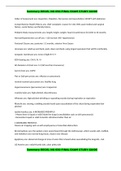Summary REGIS. NU 650 FINAL EXAM STUDY GUIDE
Order of Assessment ans: Inspection, Palpation, Percussion and Auscultation. EXCEPT with abdomen
Comprehensive Health History ans: chief complaint, reason for visit, ROS, past medical and surgical history, social history and family history
Pediatric Body measurements ans: length, height, weight, head circumference fro birth to 36 months
Normal/Hypertension cut off ans: <130 normal 140+ hypertension
Fontanel Closure ans: posterior 1-2 months, anterior 9mo-2years
otoscope ans: adult-up and back, peds- down and back, using largest speculum that will fit comforably
tympanic membrane ans: Cone of light R-5 l-7
EOM testing ans: CN III, IV, VI
AP diameter of chest ans: 1:2 (AP less than transverse)
barrel chest ans: COPD
Flat or Dull percussion ans: effusion or pneumonia
normal resonant percussion ans: healthy lung
Hyperressonance (percussion) ans: trapped air
crackles/rales ans: high pitched, discontinuous
Wheezes ans: high-pitched whistling or squeaking sounds during inspiration or expiration
Rhonchi ans: snoring, rumbling sounds heard upon auscultation of the chest during respiration-low pitched
tactile fremitus ans: • INCREASED FREMITUS
- Means there is liquid or solid inside the lungs (consolidation such as with pneumonia)
- Remember Liquid or solid transmits vibrations better than air
• DECREASED FREMITUS
Means air trapping such as with emphysema or bronchial obstruction.
Bronchophony ans: the spoken voice sound heard through the stethoscope, which sounds soft, muffled, and indistinct over normal lung tissue, clearer over disease
Egophony ans: abnormal change in tone of voice that is heard when auscultating the lungs EE-->AA
UE Arteries ans: radial-thumb side, ulnar pinky side
Summary REGIS. NU 650 FINAL EXAM STUDY GUIDE Summary REGIS. NU 650 FINAL EXAM STUDY GUIDE
Pulse grading ans: 0 absent
1+ weak
2+ normal
3+ increased
4+ bounding
palpate bilaterally
PMI ans: point of maximal impulse mid-clavicular and 5th ICS
S1 ans: normal, closure of AV, Start of systole, loudest at Apex, contraction of ventricles
S2 ans: normal, closure of semilunar, end of systole, loudest at base, filling of ventricles
S3 ans: third heart sound (normal in pregnant young adults, and children), gallop
S4 ans: extra heart sound, end of diastole, indicative of disease-AFIB
murmur grading scale ans: I-Barely Audible
II-Quiet, Clearly Audible
III-moderately Loud
IV-loud, thrill
V-Very loud, can palpate thrill
VI-Very loud, thrill palpable and visible
clubbing ans: bulbous enlargement of distal phalanges of fingers and toes that occurs with chronic cyanotic heart and lung conditions
edema scale ans: 1+ = disappears rapidly. 2+ = last 10-15 seconds. 3+ = lasts more than one minute. 4+ = lasts 2-5 minutes. These are signs used in what scale?
normal/abnormal findings spleen ans: normal=tympanic, dullness could be enlargement not normally felt on exam
Blumberg Sign: Rebound Test ans: peritoneal inflammation, hurts more when release from palpation
shifting dullness ans: a sign of free peritoneal fluid wherein the dullness of percussion shifts, generally from one side to the other, as the patient is turned from side to side.
Psoas sign ans: RLQ pain with extension of right thigh indicative of appendicitis
Obturator sign ans: RLQ on internal rotation of right thigh indicative of appendicitis
assessment of hernia ans: pt may report a lump. observe pt while lying and standing, hernia may disappear while lying. ask pt to strain or perform Valsalva maneuver and observe for bulging. absent bowel sounds may indicate strangulation.
Summary REGIS. NU 650 FINAL EXAM STUDY GUIDE




